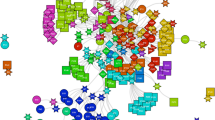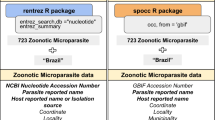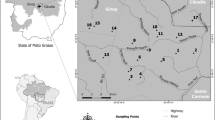Abstract
Small mammals not only play an important role in biodiversity, but also act as dynamic hosts and reservoirs for a variety of parasites that are of public health importance. Furthermore, host–parasite associations are driven by complex ecological interactions, and the parasite species dynamics are explained by several factors. In this work we aim to verify the association between parasitic infections in small Brazilian mammals. Here, we carried out a systematic review to verify the distribution of parasites in small Brazilian mammals; later we carried out a network analysis to assess the host–parasite associations of the results found. We found 110 studies that included all groups of parasites. We compiled a set of networks with the different groups of parasites (except viruses and fungi due to the small number of records). The most widespread host species were Akodon cursor, A. montensis, Clyomys laticeps, Didelphis albiventris, D. aurita, D. marsupialis, Necromys lasiurus, Nectomys squamipes, Oligoryzomys nigripes, Thaptomys nigrita, and Thrichomys fosteri, that occurred in the four networks. All networks had modular patterns, except for Helminth’s network. A phenomenon known as aggregation in parasitology was observed in our review with many associations of small mammals and parasites. Furthermore, rodents and marsupial species are highly diversified and have the potential to be sources of pathogens, directly or indirectly through vectors. Therefore, understanding the host–parasite relationship is essential, not only for the ecological history of the hosts and/or parasites, but also for its importance for public health in disease transmission.



Similar content being viewed by others
Data availability
We agreed.
Code availability
Not applicable.
References
Abreu EF, Casali DM, Garbino GST, Libardi GS, Loretto D, Loss AC, Marmontel M, Nascimento MC, Oliveira ML, Pavan SE, Tirelli FP (2021) Lista de Mamíferos do Brasil, versão 2021–1. In: Comitê de Taxonomia da Sociedade Brasileira de Mastozoologia (CT-SBMz). https://sbmz.org/mamiferos-do-brasil/. Accessed 28 Oct 2021
Aléssio, F. M., Dantas-Torres, F., Siqueira, D. B., Lizée, M. H., Marvulo, M. F. V., Martins, T. F., Labruna, M. B., Silva, J. C. R., & Mauffrey, J. F. (2012). Ecological implications on the aggregation of Amblyomma fuscum (Acari: Ixodidae) on Thrichomys laurentius (Rodentia: Echimyidae), in northeastern Brazil. Experimental and Applied Acarology, 57, 83–90. https://doi.org/10.1007/s10493-012-9531-3
Anderson, R. M., & May, R. M. (1979). Population biology of infectious diseases: Part I. Nature, 280, 361–367. https://doi.org/10.1038/280361a0
Andrade, M. S., Courtenay, O., Maria, M. E., Carvalho, F. G., Carvalho, A. W. S., Soares, F., Carvalho, S. M., Costa, P. L., Zampieri, R., Floeter-Winter, L. M., Shaw, J. J., & Brandão-Filho, S. P. (2015). Infectiousness of sylvatic and synanthropic small rodents implicates a multi-host reservoir of Leishmania (Viannia) braziliensis. PLoS Neglected Tropical Diseases, 9, 1–14. https://doi.org/10.1371/journal.pntd.0004137
Ashford, R. W. (1996). Leishmaniasis reservoirs and their significance in control. Clinics in Dermatology, 14, 523–532. https://doi.org/10.1016/0738-081X(96)00041-7
Ashford, R. W. (1997). What it takes to be a reservoir host. Belgian Journal of Zoology, 127(Suppl), 85–90.
Bianchi, R. D. C., Olifiers, N., Gompper, M. E., & Mourão, G. (2016). Niche partitioning among mesocarnivores in a Brazilian wetland. PLoS ONE, 11, 1–17. https://doi.org/10.1371/journal.pone.0162893
Cornwell, W. K., & Ackerly, D. D. (2009). Community assembly and shifts in plant trait distributions across an environmental gradient in coastal California. Ecological Monographs, 79, 109–126. https://doi.org/10.1890/07-1134.1
de Sousa, K. C. M., Herrera, H. M., Rocha, F. L., Costa, F. B., Martins, T. F., Labruna, M. B., Machado, R. Z., & André, M. R. (2018). Rickettsia spp. among wild mammals and their respective ectoparasites in Pantanal wetland. Brazil. Ticks and Tick-Borne Diseases, 9, 10–17. https://doi.org/10.1016/j.ttbdis.2017.10.015
de Sousa, K. C., Herrera, H. M., Secato, C. T., Vali Oliveira, A., Santos, F. M., Rocha, F. L., Barreto, W. T., Macedo, G. C., de Andrade Pinto, P. C., Machado, R. Z., & Costa, M. T. (2017). Occurrence and molecular characterization of hemoplasmas in domestic dogs and wild mammals in a Brazilian wetland. Acta Tropica, 171, 172–181. https://doi.org/10.1016/j.actatropica.2017.03.030
Hamilton, P. B., Gibson, W. C., & Stevens, J. R. (2007). Patterns of co-evolution between trypanosomes and their hosts deduced from ribosomal RNA and protein-coding gene phylogenies. Molecular Phylogenetics and Evolution, 44, 15–25. https://doi.org/10.1016/j.ympev.2007.03.023
Hamilton, P. B., Stevens, J. R., Gaunt, M. W., Gidley, J., & Gibson, W. C. (2004). Trypanosomes are monophyletic: Evidence from genes for glyceraldehyde phosphate dehydrogenase and small subunit ribosomal RNA. International Journal for Parasitology, 34, 1393–1404. https://doi.org/10.1016/j.ijpara.2004.08.011
Herrera, H. M., Rocha, F. L., Lisboa, C. V., Rademaker, V., Mourão, G. M., & Jansen, A. M. (2011). Food web connections and the transmission cycles of Trypanosoma cruzi and Trypanosoma evansi (Kinetoplastida, Trypanosomatidae) in the Pantanal Region, Brazil. Transactions of the Royal Society of Tropical Medicine and Hygiene, 105, 380–387. https://doi.org/10.1016/j.trstmh.2011.04.008
Horta, M. C., Guimarães, M. F., Arraes-Santos, A. I., Araujo, A. C., Dubey, J. P., Labruna, M. B., Gennari, S. M., & Pena, H. F. J. (2018). Detection of anti-Toxoplasma gondii antibodies in small wild mammals from preserved and non-preserved areas in the Caatinga biome, a semi-arid region of Northeast Brazil. Veterinary Parasitology: Regional Studies and Reports, 14, 75–78. https://doi.org/10.1016/j.vprsr.2018.08.007
Krasnov, B. R., Korallo-Vinarskaya, N. P., Vinarski, M. V., Shenbrot, G. I., Mouillot, D., & Poulin, R. (2008). Searching for general patterns in parasite ecology: Host identity versus environmental influence on gamasid mite assemblages in small mammals. Parasitology, 135, 229–242. https://doi.org/10.1017/S003118200700368X
Lima, M., Julliard, R., Stenseth, N. C., & Jaksic, F. M. (2001). Demographic dynamics of a neotropical small rodent (Phyllotis darwini): Feedback structure, predation and climatic factors. Journal of Animal Ecology, 70, 761–775. https://doi.org/10.1046/j.0021-8790.2001.00536.x
Looijen, R. C., & Van Andel, J. (1999). Ecological communities: Conceptual problems and definitions. Perspectives in Plant Ecology, Evolution and Systematics, 2, 210–222. https://doi.org/10.1078/1433-8319-00071
Nava, S., & Lareschi, M. (2012). Ecological characterization of a community of arthropods parasitic of sigmodontine rodents in the argentinean chaco ecological characterization of a community of arthropods parasitic of sigmodontine rodents in the argentinean Chaco. Journal of Medical Entomology, 49, 1276–1282.
Noireau, F., Diosque, P., & Jansen, A. M. (2009). Trypanosoma cruzi: Adaptation to its vectors and its hosts. Veterinary Research. https://doi.org/10.1051/vetres/2009009
Ostfeld, R. S., Hazler, K. R., & Cepeda, O. M. (1996). Temporal and Spatial Dynamics of Ixodes scapularis (Acari: Ixodidae) in a Rural Landscape. Journal of Medical Entomology, 33, 90–95. https://doi.org/10.1093/jmedent/33.1.90
Poulin R, Morand S (2000) The quarterly review of biology September.
Poulin, R. (1999). Body size vs abundance among parasite species: Positive relationships? Ecography, 22, 246–250. https://doi.org/10.1111/j.1600-0587.1999.tb00499.x
Poulin, R. (2007). Evolutionary ecology of Parasites (2nd ed.). Princeton University Press.
Poulin, R., & Dick, T. A. (2007). Spatial variation in population density across the geographical range in helminth parasites of yellow perch Perca flavescens. Ecography, 30, 629–636. https://doi.org/10.1111/j.2007.0906-7590.05139.x
Quintão-Silva, M. G., & Ribeiro, M. F. B. (2003). Infection Rate of Babesia spp. Sporokinetes in Engorged Boophilus microplus from an Area of Enzootic Stability in the State of Minas Gerais. Brazil. Memorias Do Instituto Oswaldo Cruz, 98, 999–1002. https://doi.org/10.1590/S0074-02762003000800003
Radovsky, F. J. (1985). The evolution of Parasitism and the Distribution of Some Dermanyssoid Mites (Mesostigmata) on Vertebrate Hosts. In K. Kim (Ed.), Coevolution of parasitic arthropods and mammals (pp. 441–504). Wiley.
Santos, F. M., de Sousa, K. C. M., Sano, N. Y., Nantes, W. A. G., Liberal, S. C., Machado, R. Z., André, M. R., & Herrera, H. M. (2021). Relationships between vector-borne parasites and free-living mammals at the Brazilian Pantanal. Parasitology Research, 120, 1003–1010. https://doi.org/10.1007/s00436-020-07028-0
Simpson, A. G. B., Stevens, J. R., & Lukeš, J. (2006). The evolution and diversity of kinetoplastid flagellates. Trends in Parasitology, 22, 168–174. https://doi.org/10.1016/j.pt.2006.02.006
Sonenshine, D. E., & Stout, J. (1968). Tick burdens in relation to spacing and range of hosts in Dermacentor variabilis. Journal of Medical Entomology, 5, 49–52. https://doi.org/10.1093/jmedent/5.1.49
Sponchiado, J., Melo, G. L., Martins, T. F., Krawczak, F. S., Jacinavicius, F. C., Labruna, M. B., Barros-Battesti, D. M., & Cáceres, N. C. (2017). Ectoparasites of small-mammals: Determinants of community structure in South American savannah. Parasitology, 144, 475–483. https://doi.org/10.1017/S0031182016001906
Tenter, A. M., Heckeroth, A. R., & Weiss, L. M. (2000). Toxoplasma gondii: From animals to humans. International Journal for Parasitology, 30, 1217–1258. https://doi.org/10.1016/S0020-7519(00)00124-7
Thomas, F., Guégan, J. F., Michalakis, Y., & Renaud, F. (2000). Parasites and host life-history traits: Implications for community ecology and species co-existence. International Journal for Parasitology, 30, 669–674. https://doi.org/10.1016/S0020-7519(00)00040-0
Timm, R. M. (1983). Fahrenholz’s rule and resource tracking: A study of host-parasite coevolution. In M. Nitecki (Ed.), Coevolution (pp. 225–265). University of Chicago Press.
Tompkins, D. M., & Begon, M. (1999). Parasites can regulate host pops. Parasitology Today, 15, 311–313.
Ward, S. A. (1992). The American naturalist. The American Naturalist, 139, 883–891.
Yan, C., Liang, L. J., Zheng, K. Y., & Zhu, X. Q. (2016). Impact of environmental factors on the emergence, transmission and distribution of Toxoplasma gondii. Parasites and Vectors, 9, 1–7. https://doi.org/10.1186/s13071-016-1432-6
Acknowledgements
This study was funded “Conselho Nacional de Desenvolvimento Científico e Tecnológico” — CNPq (406547/2018-1) and “Coordenação de Aperfeiçoamento de Pessoal de Nível Superior” — CAPES (Finance Code 001), and we gratefully acknowledge the receipt of the grants 88887.162877/2018-00 (FMS—CAPES) and 88887.194498/2018-00 (NYS CAPES).
Funding
First author thanks Coordenação de Aperfeiçoamento de Pessoal de Nível Superior (CAPES) for the fellowship (88887.369261/2019–00). NYS receive a fellowship from CAPES (88887.194498/2018–00). This research was financially supported by CAPES (Finance Code 001).
Author information
Authors and Affiliations
Contributions
FMS and NYS contributed to conceptualization and data curation; FMS contributed to methodology; FMS and NYS contributed to validation; FMS contributed to visualization and writing—original draft; FMS and NYS contributed to writing—review & editing.
Corresponding author
Ethics declarations
Conflicts of interest
The authors have no conflict of interest.
Ethics approval
Not applicable.
Consent to participate
Both authors consent to participate in this manuscript.
Consent for publication
Both authors consent for publication of this manuscript in the Community Ecology.
Supplementary Information
Below is the link to the electronic supplementary material.
Rights and permissions
About this article
Cite this article
Santos, F.M., Sano, N.Y. Parasite association in non-volant small mammals in Brazil. COMMUNITY ECOLOGY 23, 129–136 (2022). https://doi.org/10.1007/s42974-022-00080-z
Received:
Accepted:
Published:
Issue Date:
DOI: https://doi.org/10.1007/s42974-022-00080-z




